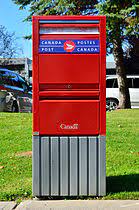
I’m taking half an hour at the end of most work days to finally read through some of the letters that my sister, April Henderson, who died in November 2018, either sent or received. She saved almost everything, including letters that weren’t even to her but were to friends or relatives who knew of her interest in those around her.
I’ve found a lot to be sad about in relationships within our family.
But enough about the sadness. I want to focus on two things that this whole experience is bringing home to me. Neither will surprise you if you’re over 50 years old or even under 50 with a sense of recent history.
The first is the fact of the letters themselves. They’re often between my mother, living in Carman, Manitoba in the mid-1960s, and April, who, having graduated from high school in 1964, went to work in Winnipeg. Those two places are only 50 miles apart, but with the price of long-distance phone calls and my mother’s and sister’s very tight budgets, writing was really the only efficient way of communicating.
I emphasize that this probably shouldn’t come as a surprise to anyone reading this. But still, it just hit me over the head. It made me realize all the ways we can keep in touch and not wait until we find time to write and then wait again for the Canadian or U.S. postal service to deliver.
The second is monetary magnitudes. For some reason, my Aunt Ruby, who was my favorite great aunt, shared with my sister some correspondence she had with her nephew (my uncle) in 1949. My uncle was asking her for a loan and he listed the various expenses that had put him in debt, plus existing debts. Here they are:
Dr. Upton (dentist): $28.00
Dr. Corley: $48.00
Publishers Guild (books): $8.00
Prescription drugs: $12.00
Holy Cross hospital: $26.00
General Hospital: $15.00
Union Tractor and Equipment (his employer): $15.00 for new glasses and safety boots
Bank payment: $35.00
Clothes for children: $10.65
Clothes for ourselves: $14.75
Household finance (debt): $200.00
Mom and Dad (debt): $200.00
About behind on grocery bills: $40.00
Grand total: $652.40.
Obviously, all the amounts are low because they’re in 1949 dollars. The Canadian CPI in 1949 was 12.2 and rose to 157.1 by 2023. That’s an increase of 1188 percent.
So $652.40 would be $8,401 today, still a sizable amount. If we compare it to average wages, it’s even a bigger bite, probably on the order of $25,000.
Here’s what I found more interesting: relative prices. A hospital charged $26.00, I think for my aunt’s delivery of one of her sons. Adjust for inflation and you get $335.00. And remember that few people in Canada at the time, just as in the United States, had health insurance. What would $335.00 buy you today at a hospital? Not much. There are three contributors to the high price now: much higher quality–they can do more things to help you, third-party payment, and higher real doctors’ and nurses’ salaries. Oh, and add a fourth: the permit process to build new hospitals.
And while on the issue of medical care, look at the dentist. $28.00 in 1949, inflation adjusted, is $361 today. That would still buy some dental services. And notice that way fewer people have dental insurance than have health insurance. Hmmm.
I don’t know what kind of clothing they bought their 2 sons, but it’s conceivable that the real price of clothing has declined.


READER COMMENTS
steve
Jan 25 2024 at 1:15pm
No permit process in PA. Costs are still just as high as elsewhere. There are studies showing it has an effect but it is small. Otherwise you are correct. Just to show the difference I like to remind people that the family many considered the richest in the world at the time had a baby born 5 weeks early in 1963 (Kennedy baby) and the best children’s hospital care in the world, the best money could buy, couldn’t save the life of the child. Today, an otherwise healthy baby has a survival rate over 99%.
Steve
David Henderson
Jan 25 2024 at 3:45pm
Good point about the Kennedy baby.
Matthias
Jan 25 2024 at 7:29pm
See https://slatestarcodex.com/2020/04/20/the-amish-health-care-system/ for the Amish healthcare system in contemporary America. And of course a look at Singapore is also enlightening.
Pierre Lemieux
Jan 25 2024 at 3:25pm
Yes, things have changed, as Bob Dylan sings. Often for the better but not always. The trend is what matters.
Mark Barbieri
Jan 25 2024 at 9:49pm
“I don’t know what kind of clothing they bought their 2 sons, but it’s conceivable that the real price of clothing has declined.”
The BLS has a great report on called “Consumer Price Index for All Urban Consumers (CPI-U): U. S. city average, by expenditure category”. You can see it here. It uses 1982-84 as a baseline and shows how much prices have changed since then by category. While overall prices have tripled (index value 306), clothing prices have only increased by 25% (index value 126) in nominal terms. It has the lowest nominal price increase of any of the categories listed.
robc
Jan 26 2024 at 4:16pm
I used to work for a clothing manufacturing company (2015-19). They big change between the 1980s and modern is that NONE of the clothing is made in America (not entirely true, there are specialty lines, but entirely true for that company). The CEO when I started originally came to the company in the 90s (not as CEO) to lead the outsourcing effort. By the time I got there, 100% of our manufacturing was done overseas. There was a sewing center in HQ that made the prototypes. Once process was created, the products were made in Honduras, Vietnam, etc.
Comparative advantage kept clothing costs down.
Comments are closed.